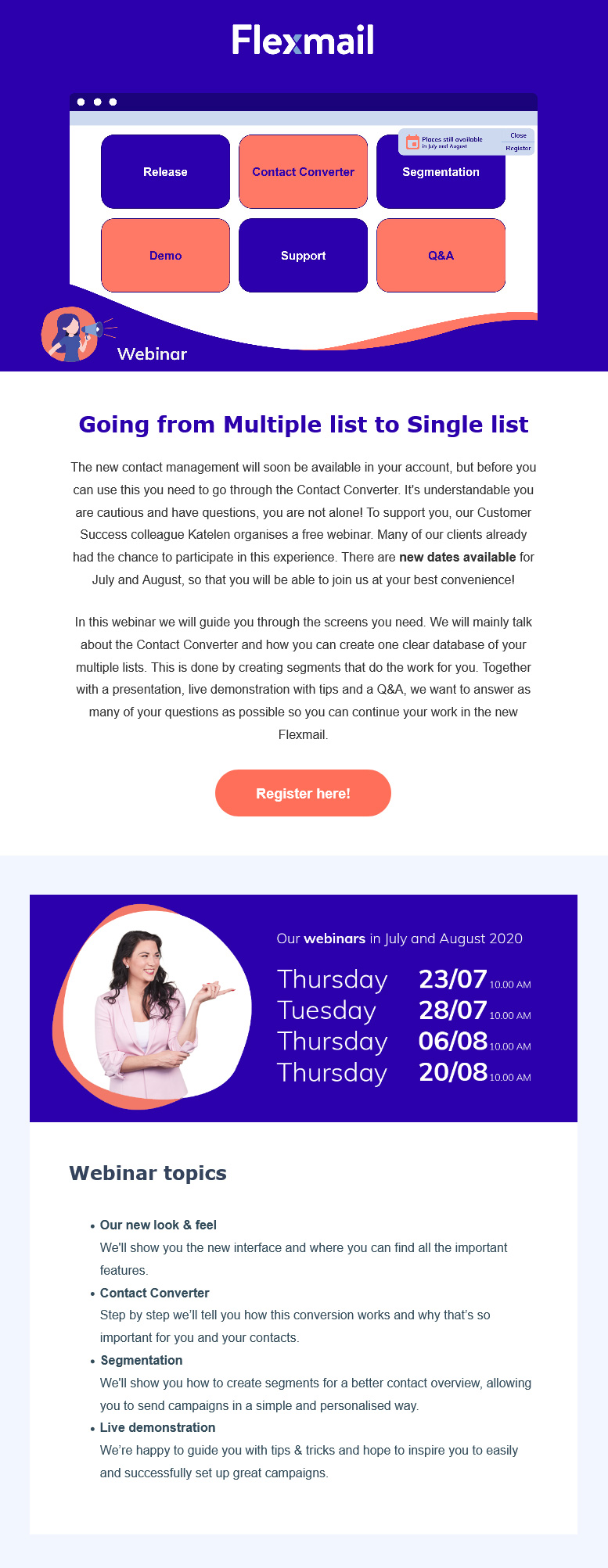In our previous article, we went into more detail about the needs of your recipients in times of COVID. And how you can get your communication out of a COVID dip.
Shortly after, we received the following question from our friends at SPRYG Real Estate Academy:A super question that everyone who is working strategically with email marketing should ask themselves.
But what emails generally score today? We looked for the common thread:
Shortly after, we received the following question from our friends at SPRYG Real Estate Academy:
Hi Michelle
You wrote great tips!
They focus on what no longer works, but not on what messages have potential right now.
You can tell better than anyone what messages work well.
So my question is: Which COVID messages are widely used and work well at the moment? Is it possible to compile a sort of top 10?
Kind regards,
Dagmar Spakman
Online Specialist
You wrote great tips!
They focus on what no longer works, but not on what messages have potential right now.
You can tell better than anyone what messages work well.
So my question is: Which COVID messages are widely used and work well at the moment? Is it possible to compile a sort of top 10?
Kind regards,
Dagmar Spakman
Online Specialist
But what emails generally score today? We looked for the common thread:
1. Many emails are no longer about COVID
When we look at the campaigns that deal specifically with COVID and that get good results, we see they are mainly informative emails.The real winner in terms of open rate was a campaign with the subject: "COVID compensation". Super clear, super relevant.
2. Automated emails get better open rates
The potential positive impact of automation on your results is often significantly underestimated. The condition, of course, is that you choose your target groups carefully and really tailor your content to them.The success rate of automation is so high because the target audience is so specific. And that’s more than clear in the results.
Recent automated emails with the highest open rates:
- Onboarding campaigns after subscription or purchase (and corresponding reminders)
- Appointment reminder emails
If your contacts read your welcome mail, the chance that they will read subsequent emails also increases exponentially. It’s important to offer contacts added value immediately to let them know it was a good idea to subscribe and get to know your products or services better.
There is an underlying reason for this: the algorithms of email clients that determine whether emails are relevant keep a close eye on your content and the reader's reaction. The future delivery of your emails to the inbox of the contacts who open the initial email would increase by 87%.
Onboarding email flows that clearly offer immediate value with series of emails containing tips often easily reach an open rate of 50%. We have even seen emails with an open rate of 90%! If you are not sending out a welcome email, you are missing out on a huge opportunity.
3. Send what people expect
Welcome emails bring us straight to the next tip: send what people expect. A thank you email is a perfect example of this principle. It may seem obvious, but your recipients are really waiting for that reassurance. You send it after a subscription, download or any other possible commitment your recipient makes.If the subject actually says "thank you", the open rates are usually higher.
4. Communication about webinars has been doing exceptionally well lately
Your readers are also in a COVID dip. They may feel cooped up at home, looking forward to meeting up again and doing fun things. But another way of breaking through the rut and getting in touch with people seems to be webinars. People are looking for inspiration and want to learn or gain strategic advantage.The open rates of emails about webinars and online courses stand out because of it.
This also applies to reminders. Even if a contact does not subscribe, they do not seem to cause a remarkable increase in unsubscribes. So don't be afraid to sell your course.
A good strategy is to send several invitations, but to highlight different aspects each time:
- What is it about?
- Can you highlight a guest speaker?
- HHow many places are left?
- Can you give some tips in advance?
- Do participants get anything extra?
Extra tip: the lower the number of subscriptions, the better the response :-)
5. Recurring newsletters continue to score well
With all these best practices and targeting techniques, you’d almost forget about everyday newsletters. Although you often have to deal with extremes. When does a newsletter still work?- You have absolute permission from your readers to send them emails, so you only email everyone who has specifically signed up for the newsletter (via a preference centre, for example).
- You keep a very regular and predictable pace (e.g. once a month at a fixed time).
- Your readers are used to receiving truly informative content from you.
Often, the information is specific or responds directly to pain points or needs of the target group. In April and May, for example, we saw the following topics pass by with high open rates:
- Information on taxes
- Articles about wellbeing
- Campus tours, digital lectures
- Domestic tourism tips
- Information on recent problems (e.g. delivery)
- Retirement of a beloved employee (especially if that person often comes into contact with customers). It also shows the human side of your business.
- Cancellation of an event
- Results of studies
6. Take-away menus and renovation content stand out
It goes without saying that the content that continued to score extremely well over recent weeks is about take-away or renovation. Makes sense, people are sitting at home and are looking for things to do and cosy nights in. Is there an angle for you to hook into ? Go for it! People are clearly not tired of it yet.7. The more specific the segments, the better the open rate generally is
In addition to the trusted newsletter, people want to receive content that is specifically tailored to them. We can see this in the open rates: the more specific the target group, the better the results. That is why automation works so well: you respond to actions that your recipient performs.You can easily start with segmentation yourself. First of all, look at the data you already have. Need some inspiration? Read our tips and possible pitfalls here.
8. Now is the time to send out surveys
It is striking to see not only the number of satisfaction surveys and other enquiries that were sent out over recent weeks, but also their incredible open rates.9. Teleworking makes clear internal communication more important than ever
Remote working offers more flexibility, security and trust for your employees, but internal communication is essential for everyone to work well together. It can be difficult to get everyone on a call at the same time, and you want to make sure everyone is aware of important information.Which internal emails with high scores did we see?
- Internal newsletter
- Welcoming new colleague
- Onboarding scenarios for new colleagues
- Anniversary of a colleague
- Make sure the information you provide is actually useful
- Indicate where people can go for feedback or more info
- Be brief when possible
- List the most important info
- Put an employee in the spotlight
- Use personalisation for the subject line and content
- Take note of tone. Written word is more susceptible to interpretation.
10. Companies now waking up from COVID hibernation should watch out for their deliverability
In our previous article, we already went over the importance of regular emailing, which is now clearly reflected in the results.When we see campaigns with a high bounce rate, we are usually either dealing with purchased lists or the sender has not sent any emails for a long time, in which case recipients don’t even remember subscribing.
This will not only mess up your results, but spam filters and email clients will also find it suspicious. Not quite sure how to start with an email strategy? In our master class, we guide you through the necessary steps.
To conclude, we’d love to share this clever A/B testing tip from Dagmar with SPRYG Real Estate Academy:
The trends and what does and doesn’t work in times of COVID in terms of marketing messages are rapidly changing at the moment, it is almost impossible to keep up!There is really no time for companies to do long A/B tests and not every Flexmail user will have a large database to perform extensive A/B tests quickly.
This is how I have been handling it in our online marketing since the COVID-19 pandemic started in 2020:
First, test various messages in online social media ads with a large target group to see which messages catch on. If they convert or have a high CTR, take those findings into Flexmail emailings and A/B test them there too.
You’ll quickly end up with specific results of messages that work for your target group and a concrete A/B test case that you can immediately extend into Flexmail - and you’ll be using all of your online marketing channels optimally.
 Michelle Dassen
Michelle Dassen





